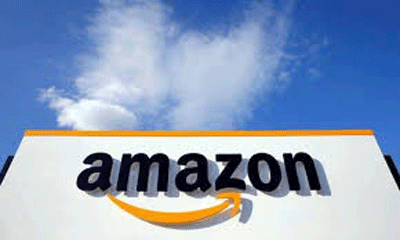The Center’s Chief Strategy Officer Brad Berens explores why Amazon would create a free, ad-supported streaming service to rival its own Prime Video on Demand. (Spoiler alert: it’s all about Walmart.)
_______________________________________________________________________________________
By Brad Berens
Late last month, the business rumor mill exploded with the story that Amazon subsidiary IMDB was to launch “Free Dive,” an ad-supported streaming video service that would be free to anybody who had an Amazon Fire TV device.
 Free Dive would be distinct from Amazon’s mostly ad-free Prime Video on Demand service because no Amazon Prime subscription would be needed. In addition, Free Dive would feature no original content — just old movies and TV shows — so it’s not a cheapskate’s end-run around the $119 annual Prime fee that gets one access to shows like Transparent, Jack Ryan, and The Marvelous Mrs. Maisel, not to mention unlimited two-day shipping.
Free Dive would be distinct from Amazon’s mostly ad-free Prime Video on Demand service because no Amazon Prime subscription would be needed. In addition, Free Dive would feature no original content — just old movies and TV shows — so it’s not a cheapskate’s end-run around the $119 annual Prime fee that gets one access to shows like Transparent, Jack Ryan, and The Marvelous Mrs. Maisel, not to mention unlimited two-day shipping.
Much of the press coverage around Free Dive focused on how it would extend Amazon’s multi-pronged approach to advertising. For example, in Fortune:
Advertising has quietly become reliable area of growth for Amazon in recent years. The company’s “other” revenue segment, which mostly comes from ad revenue, grew by 132% in the second quarter from a year earlier to $2.2 billion.
“It’s now a multi-billion dollar business for us,” Amazon CFO Brian Olsavsky said during the company’s most recent earnings call. “We’re seeing strong adoption across a number of fronts—Amazon vendors, sellers, authors as well as third-party advertisers who want to reach Amazon customers.”
Or this passage from Reuters:
Highly profitable ad sales were a bright spot for Amazon last quarter, as the company’s revenue from the category and some other items grew 132 percent to $2.2 billion.
It’s important to put this $2.2 billion number into context: that same quarter Amazon reported a total revenue of $52.9 billion. Advertising revenue represents a little more than four percent of Amazon’s total quarterly revenue, and that four percent is spread across a number of different initiatives. Amazon is certainly ambitious when it comes to advertising, but Free Dive represents only incremental revenue gains on its own.
Followers of Amazon’s unique strategies know that the company will accept a loss in one corner of its business if that loss causes people to buy more stuff, more often.
Amazon Prime is the paradigmatic example: the company loses money on two-day shipping for many purchases, and it is spending billions of dollars on creating original content and licensing other content. But the reason Amazon does this is that Prime members buy more than non-Prime members, and Prime members also increase their Amazon spending by up to 12 percent each year that they subscribe.
_________________________________________________________________________________________________
While the Free Dive ad revenue will quickly grow to be substantial, the biggest advantage that the service gives to Amazon is in growing the awareness of Walmart shoppers that Amazon is a great place to shop, too.
_________________________________________________________________________________________________
What this suggests is that if Amazon is launching a peripheral streaming video service the thing to do is drill down on what else the new service will accomplish beyond increased advertising revenue.
The new Free Dive service is likely to have two striking benefits.
First, Amazon’s benefits from Free Dive go way beyond the advertising revenue because as often as possible the ads on Free Dive will direct viewers to make an eventual purchase on Amazon.com.
Even if the ad itself does not contain an explicit “go to Amazon.com to order this today” message, Amazon will be able to place promotional messages for its service in every cluster of commercials, so viewers will be primed (in the psychological sense) to buy on Amazon.
Second, Free Dive is a way for Amazon to get in front of the Walmart customer. Walmart, Amazon’s biggest rival, has taken pains to let its customers know that when they order something from Walmart.com that costs $35 or more, the two-day shipping is free with no Prime subscription required.
Walmart focuses its brand on both the appearance and reality of everyday low prices, and there are many Walmart brand loyalists. It’s telling that Amazon is not calling Free Dive “Amazon Free Dive,” and is launching the service under its wholly-owned IMDB brand because that’s a way of getting Amazon deals in front of viewers without making them visit Amazon.com.
While the Free Dive ad revenue will quickly grow to be substantial, the biggest advantage that the service gives to Amazon is in growing the awareness of Walmart shoppers that Amazon is a great place to shop, too.
At the same time, Walmart is rumored to be launching its own streaming video service, targeted at Middle America and priced at eight dollars per month. That’s cheaper than the $12.99 that Prime averages out to monthly and also cheaper than most Netflix plans.
But it’s not free, like Free Dive.
It’s hard to argue with free. With Free Dive, Amazon’s hypothesis, I suspect, is that viewers will make the traditional TV bargain of trading attention to ads for free content—in this case, free content that simultaneously directs attention to Amazon.
__________

Brad Berens is the Center’s Chief Strategy Officer.
See all columns from the Center.
September 12, 2018

